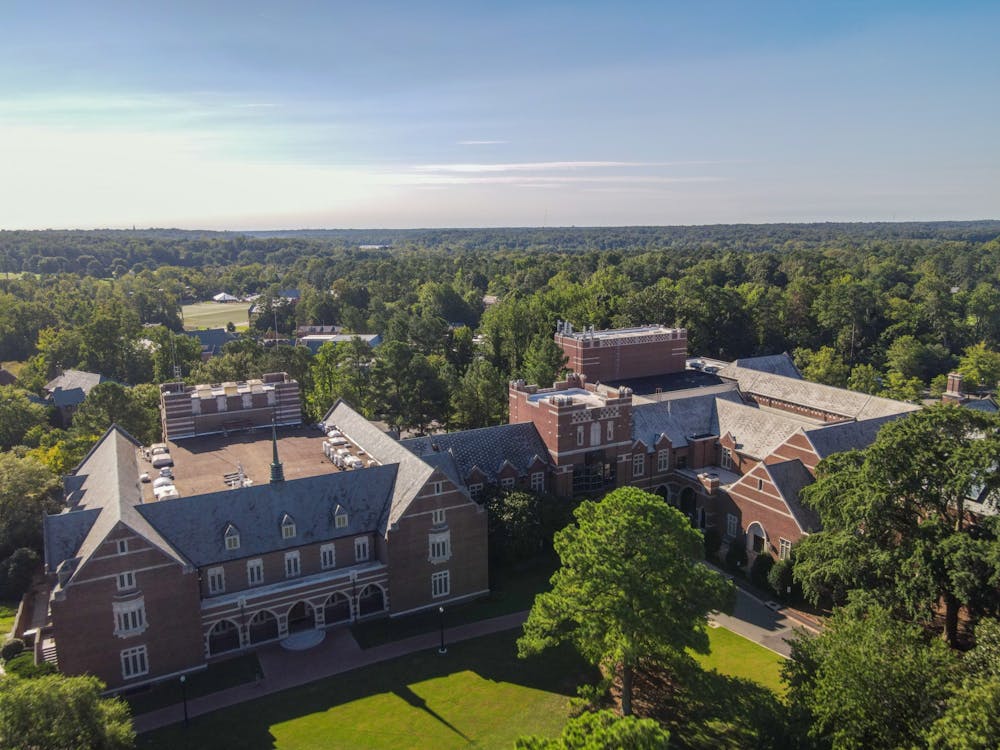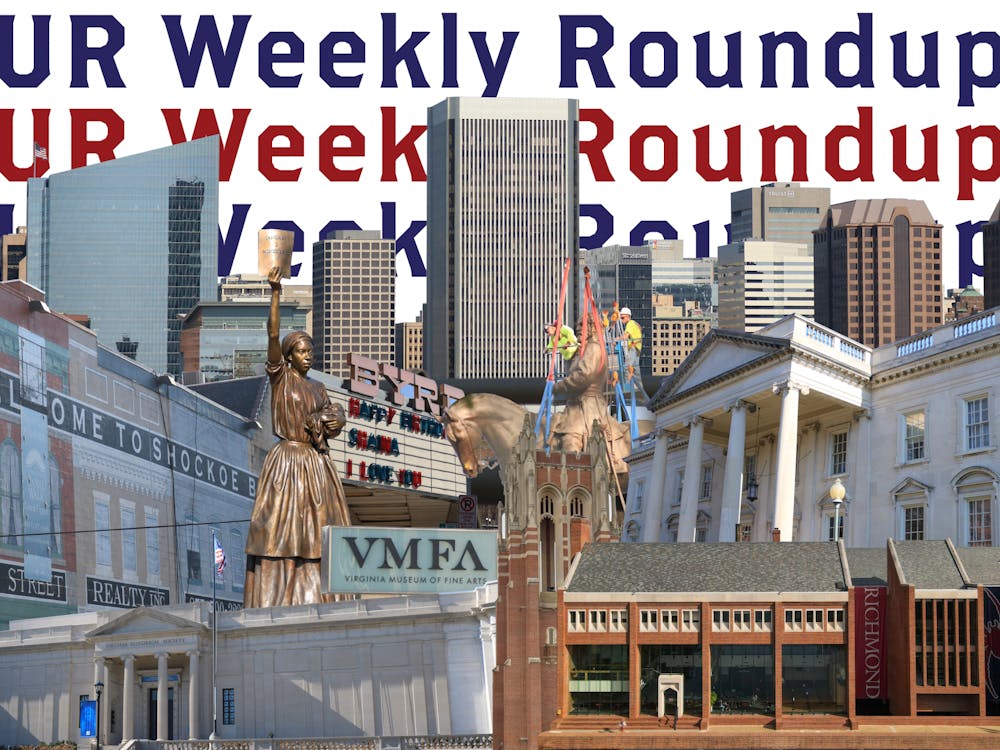Editor's Note: The managing editor of The Collegian is co-captain of University Dancers.
The University of Richmond’s Department of Theater and Dance has had to significantly adapt its operations this semester to accommodate COVID-19 protocols in its classroom and performance settings.
Though the social distancing guidelines present unique challenges to theater and dance, two physical art forms, the department had been creative and flexible in finding solutions, said Walter Schoen, chair of the department and theater professor.
“We just took each change and protocol that developed and considered, ‘How can we continue to provide students with opportunities?’" Schoen said. "That really has been the underlying focus of all the decisions we’ve made starting way back in May and up to and including the announcement that we’re moving into the Orange Phase."
One major change for the entire department is the style of performance production, Schoen said.
Schoen is directing a production of William Shakespeare’s Richard III this fall, set to open Nov. 11. In a change from previous productions, Richard III will be performed outdoors, in the Jenkins Greek Theater, he said.
“We’ve been given permission to use the theater outside and given an exemption for the actors when they are on stage not to wear masks," Schoen said. "Because the audience will be distant enough, and I have staged the play so that the actors are physically distanced from one another."
A new play called Blood at the Root will be performed entirely through Zoom in February 2021, Schoen said.
University Dancers’ 36th annual dance concert TIME | IN | SPACE will be streamed rather than performed before an in-person audience, Anne Van Gelder, director of dance and artistic director of University Dancers, said.
These moves to virtual performance have meant that scenic design courses have had to reconsider what scenery might look like, said Josafath Reynoso, professor of scenic design.
“I personally have had to move away almost entirely from the scene shop, where we build and paint the scenery for our shows, and instead focus on the technological alternatives such as virtual scenery, green screen filming and editing,” Reynoso said.
Although not all department courses' content were changed, the department has had to respond creatively to COVID-19 protocols.
Enjoy what you're reading?
Signup for our newsletter
“Most dance classes have been moved to the Alice Jepson Theater due to distancing requirements and capacity limits in the dance studios," Van Gelder said. "Masks are required for everyone. Enhanced cleaning protocols are in place including additional cleaning of the specialized dance floors in all studios and teaching spaces.”
Most in-person acting classes are in theater spaces rather than classrooms, and all department classes are offered to remote students, Schoen said.
The hybrid model has challenged dance students, but lessons learned from the spring 2020 semester have been applied this fall, Van Gelder said.
“Most [dance] classes have a student tech assistant to navigate any issues with Zoom, Solstice, audio, video or any other technical needs regarding the set-up of the system," Van Gelder said. "This makes it possible for each faculty member to focus on teaching their class.”
Karen Fleming, senior and co-captain of UD, said that, although this semester had made studying dance more difficult, she had been thankful for the opportunities made available through Zoom.
“We’ve been working with guest choreographers still," Fleming said. "Usually we have artists come for a week or so [who] set new works for UD, but since we can’t have visitors to campus this semester, we are working with these choreographers over Zoom.
"There’s a big TV screen in the theater, and [the choreographers] join the Zoom call and we learn a dance through a screen, which poses its own challenges. But the fact that we can still have that experience is amazing."
Although in-person learning is best, it is definitely possible to learn a choreographer’s specific style and choreography in a virtual format, Van Gelder said.
Valentina Rodriguez, sophomore and member of UD, is studying remotely this semester, taking one dance course in addition to the UD technique classes.
“For UD, choreographers are doing virtual residencies and the members of the company are learning those dances in real-time," Rodriguez said. "Since I’m remote and don’t really have a lot of space at home, I decided to take a step back and not audition for any residencies even though that option was offered to me.
"But I had the opportunity to create an individual project with a professor ... and it’s going to be like a virtual solo."
Rodriguez is the only remote dancer in UD this semester, she said. Although it has been challenging, feeling safe and learning to adapt have been positive parts of being remote this semester, she said.
For in-person dancers in UD, COVID-19 safety protocols have extended well beyond Zoom, impacting the way students interact with the studio space and each other. UD, for example, has changed its rehearsal space to maintain social distancing practices.
“We have ten-foot boxes taped out on the stage that we are supposed to stay in the whole time," Fleming said. "At the very beginning of the semester we weren’t even allowed to touch the floor with our bare hands; we had to wear gloves. We are now allowed to touch the floor which is good."
The number of dancers on stage at a time has also been reduced, Fleming said.
India Henderson, a senior acting in Richard III, said the crew for the show had similarly had to adapt.
“Stage managers are not only tracking all of our blocking [the precise staging of actors to facilitate the performance of a play], which has to be strategic and socially distant," Henderson said. "They’re also literally wiping down all the props after they are touched by just one person, and trying to make sure props end up going through the least amount of people. So finding a strategic way for a prop to make sense within a scene, but also making sure you don’t have fifteen people unnecessarily touching a prop that just three people could touch."
Schoen said he had been facing challenges with blocking and stage direction in Richard III.
“There's one moment when one of the actors is supposed to give another a ring," he said. "Well, of course, you can't get actually close enough to do that, so we've been thinking of other ways that the ring can transfer from one person to another. To a degree, [having to limit contact between actors] is almost as if the writer has written in something special that just forces you to be more creative."
Fleming and Henderson both emphasized the impact that COVID-19 restrictions, especially wearing a mask, have had on their art. Since masks and distancing can change the meaning of their performance, they have both been prompted to explore new forms of expression.
For Fleming, this means understanding COVID-19 as a specific time and place for art. Her senior capstone project for her dance major will incorporate technology in a way she never would have considered previously, she said. Her project, as of now, will incorporate a live dance performed in front of a screening of another recorded dance, playing with the juxtaposition of the two, she said.
Henderson noted the renewed importance of character development when faces are hidden.
“It’s actually really forced me to get really deep in the script," Henderson said. "Since the movement isn't always the most important thing because of limitations due to COVID[-19], it’s like the text is urging me to engage deeper with it, which has been interesting as an actress.”
Fleming, Henderson, Reynoso, Rodriguez, Schoen and Van Gelder all noted that artists are creative problem solvers and that although COVID-19 has created challenges unique to artists, none have been insurmountable.
Art is more important than ever since it is all about connection and COVID-19 has been isolating, Schoen said.
“I think there is an inherent need in human beings for human contact between audience and artists," Schoen said. "When the protocols radically change so that we can have audiences, I think there will be a renewed interest because people will want to know how artists and other human beings have dealt with the prolonged period of non-contact."
Contact features writer and multimedia producer Grace Kiernan at grace.kiernan@richmond.edu.
Support independent student media
You can make a tax-deductible donation by clicking the button below, which takes you to our secure PayPal account. The page is set up to receive contributions in whatever amount you designate. We look forward to using the money we raise to further our mission of providing honest and accurate information to students, faculty, staff, alumni and others in the general public.
Donate Now



